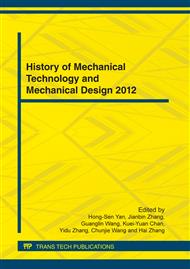p.233
p.238
p.242
p.247
p.251
p.256
p.260
p.264
p.269
Curvature Analysis of Conjugate Surfaces via a Tensor Approach
Abstract:
A novel invariant approach is proposed for derivation of curvature relationship between conjugate surfaces of line contact. Unlike other approaches found in the literature, tensor analysis is applied to the derivation process in which rigid-body motion is represented by rotation tensor and the local geometry of surface is expressed by curvature tensor, and the final result is given in a clear and compact form. An example of helical gear is provided to illustrate the application of the proposed approach.
Info:
Periodical:
Pages:
251-255
Citation:
Online since:
April 2012
Authors:
Keywords:
Price:
Сopyright:
© 2012 Trans Tech Publications Ltd. All Rights Reserved
Share:
Citation:


